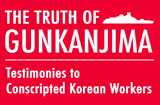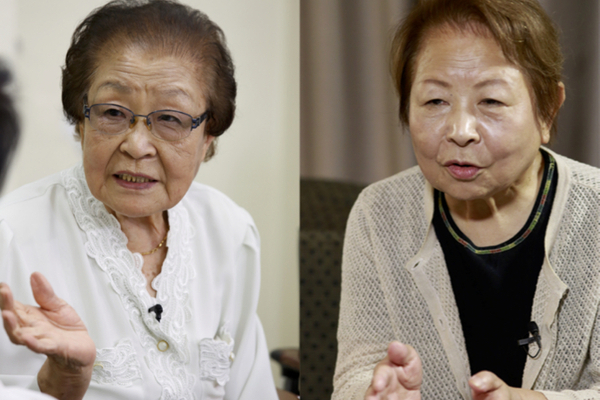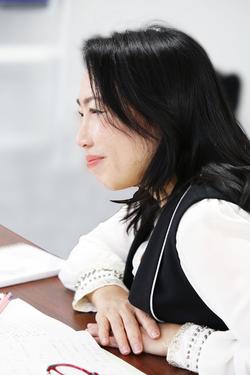Long Interview Ms. Harue Kobayashi and Ms. Kiyoko Adachi ①
General Incorporated Foundation the National Congress of Industrial Heritage
Koko Kato, Managing Director
“People on Hashima were all good people. People from the Korean Peninsula were the same way.”
Harue Kobayashi (left) and Kiyoko Adachi (right)
On a hot day in September 2016, I met Ms. Harue Kobayashi for the first time. Mr. Hideo Kaji (Chairman of the Nagasaki Hashima-kai ) had gathered several former islanders to a room at the Nagasaki City Hall to share their memories of the people from the Korean Peninsula during the war. When I mentioned that I met Mr. Sakae Matsumoto (Honorary Chairman of Hashima Islanders for Historical Truth) in Miyazaki, Mr. Hideshi Inoue, one of the participants, exclaimed in delight. “Grandpa Matsumoto is still alive?!” Hearing his voice, Ms. Harue Kobayashi leaned in. She said she and Mr. Matsumoto grew up together and were classmates. Although Ms. Kobayashi did not say much at the gathering, I realized, as we were leaving the room at the end of discussions, that she seemed to have more to say. She said “I didn’t want to dominate the conversation too much...” Thus, we decided to set up another interview session on a separate date, this time with her younger sister, Ms. Kiyoko Adachi, in a hotel room. In the second interview, perhaps because her sister was there, Ms. Kobayashi seemed much more relaxed - her face seemed brighter than it did at the group discussion. Mr. Inoue, who had already left, came back, remembering that he had more to say. The interview was long but the discussion was lively; they were eager to share their stories from the good old days. But there was never enough time to tell all the stories. Finally, a third interview was set up, this time at Harue-san’s home. Over two columns, I will introduce the sisters’ memories of living most of their lives on Hashima, until the day it closed.
Profile
Harue Kobayashi
Born January 17th, 1928 (91 years old)
Born in Takashima. Her father was a surface worker at the mine. Moved to Hashima at age 2.
Moved to Nagasaki in 1973 for her daughter’s schooling. Her husband was an electrician at the mine and lived in Hashima until the island was closed.
Kiyoko Adachi
Born August 26th, 1933 (85 years old)
Born in Hashima. During the war, she evacuated to Ehime, where her father’s ancestral home was, and stayed there until the end of the war. She subsequently moved back to Hashima and lived there until 1969. She lost her husband, who worked as an electrician in Hashima, to an accident.
“I still remember life on Hashima before the war”
--How many members were in your family?
Harue I had one older sister and three older brothers, then it was me, then a younger sister, then her (pointing to Kiyoko), and also a younger brother. There were a total of 8 kids. Everyone but us has died.
――That’s a big family.
Harue Many of the people who lived on Hashima were second-born or third-born men from places like Oita and Saga in Kyushu. The eldest son succeeds the family, but the second and third sons would come to Hashima to find work. Some came initially as single men, then went home to find wives through arranged marriages and brought them back to Hashima. I remember being introduced to the wives that way.
――Were you born in Hashima?
Kiyoko My sister (Harue) was born in Takashima, but you probably don’t remember much about the place?
Harue I was born in Takashima but moved to Hashima when I was two, so I may as well have been born on Hashima. Our father didn’t work in the pit, but he worked at the sawmill, sawing pines that were used to support the walls after digging. So his pay wasn’t as high as those that worked in the pit, and we had a lot of kids in the family... This was during the war, and the government wanted families to have more babies, so I heard that if you had more than 10 kids, you’d get financial support from the local government. I’m not sure if anyone actually got it, it was just something I heard as a kid.
Kiyoko Every family had a lot of kids, it wasn’t unusual for families to have 5 kids. In our case, our mother died young.
Harue When I was 12, my mother died from an illness at the age of 42. From there on, I had to act as the mother. Since our little brother was still alive, I couldn’t leave home without him. So I took Kiyoko to school, her hand in mine, with our little brother in tow. My teacher told me “Saeki-san,” which is my maiden name, “I know it’s hard for you, but hang in there”.
――Do you still think about Hashima?
Harue I do. Especially how it was before the war.
Kiyoko Me too. It’s funny but my memories are clearer from when I was younger.
Harue I cannot forget how much help we received from people around us. I worked really hard at being the mother, doing household chores and taking care of my little siblings, but I think we were able to survive because of the help we got from our neighbors.
――Were you in Hashima when the war ended?
Kiyoko At the end of the war, we were living in Ehime, where my father’s ancestral home was. I was 12. Our three older brothers went to war. Our eldest brother went to Manchuria, and we did not hear from him for about 10 years.
Harue I was 18 when the war ended. Or maybe 17. My memories are not clear... But I still remember how hard it was. I was drafted immediately to the Women’s Volunteer Corps in the town where we evacuated to. We manufactured airplane parts in a factory that used to be a futon factory in Imabari. When I was growing up in Hashima, cooking rice was the about the only thing I knew how to do. (At the factory) we held hammers in our hands and when the instructor blew his whistle, we’d hit the hammer…but I kept hitting my hand. Shortly after I was drafted to the Volunteer Corps, our father passed away from an illness, so I remember crying every night, because I was so sad and miserable.
Kiyoko We then went to our relative’s house in Shikoku, to a prominent farmer’s house, but because we were growing kids with big appetites, they said “you will work for this”. So we worked on the farm for 7-8 hours a day. It was the first time we had ever farmed.
Harue There are no rice fields in Hashima, so we’d never seen rice plants before. We’d never seen cows before either, so I was terrified of feeding them. I felt like I would faint, thinking about how long we would have to live that way. But then, our brothers came back, one by one, looking for us in Shikoku. They were unable to move for some time after the war ended, because of the atomic bomb, but they somehow found us and came to us.
“When we came back to Hashima from Shikoku, we thought Hashima really is the best”
Kiyoko Didn’t you say you thought Hashima was destroyed by the atomic bomb too?
Harue Did I? I just remember telling our brothers “we can’t stay here anymore. Let’s go back to Hashima”. So we basically fled Shikoku by night.
Kiyoko We left with just the clothes on our backs. We stuffed some layers that would keep us warm at night in a backpack, and we walked all the way to the station in the dark.
Harue It was very hard but we were happy to return to Hashima. I thought, Hashima is the best. Our brothers were still registered as employees of Mitsubishi, so when they returned, they were taken back immediately and were provided housing. They were paid well too.
Kiyoko It wasn’t just us. People who lived on Hashima all said “Life is good on Hashima”.
Harue We wanted to live there forever. That’s how good life was on Hashima.
Kiyoko Once you live on Hashima, it’s so comfortable there, you can’t live anywhere else. And if you work for Mitsubishi, you get housing for free and a reliable salary.
――Did you move to Nagasaki after Hashima closed?
Harue The first thing that shocked me was that the toilets were pit toilets. That’s changed now, but back then they were. When I was asked how much it costs to get our pits emptied, I was shocked. Because everything was free on Hashima. Water was free too. When we moved to Nagasaki, they used to come collect money for water. I said “oh, you have to pay for water?” because everything was free on Hashima. I was so shocked to find out. There was no place like Hashima. There were no fights. Neighbors helped each other out, like “I dont’ have soy sauce. Can I borrow some?”
“In Nagasaki, I was asked ‘Hashima, is that the famous Hell Island?’”
――Did you have time to read the material on Hashima I sent you?
Kiyoko I did see them (pamphlet from Oka Masaharu Memorial Nagasaki Peace Museum and book by Eidai Hayashi). How can they tell these lies? They are far from the truth.
Harue But it is true that even some Japanese people misunderstood Hashima. My husband stayed on Hashima until it closed, but I moved a little earlier to Nagasaki for my daughter’s school. In Nagasaki, after we moved, when I went around the neighborhood with a small gift to introduce ourselves, the old lady who lived right below us asked where we were from. When I told her we came from Hashima, she said “Oh, Hashima, you mean that famous Hell Island?”
Kiyoko What??
Harue I was so shocked. So I said “why do you call it Hell Island?”, and she answered “because people who commit crimes are sent there. That’s why it’s Hell Island.” I told her “Please visit Hashima once. There are only kind people there.” It made me angry so I told her “when one family installed an antenna for television, everyone in the neighborhood followed suit, so the rooftop became full of antennas. When one family bought a piano for their daughter, others also bought pianos for their daughters. People lived well there. Is there a place in Nagasaki that is as rich as that?” I told her as I cried. I was so angry that I could not hold back my tears.
Kiyoko That’s terrible. Hell Island is a baseless lie.
“There were only good people on Hashima. There was no discrimination for being from the Korean Peninsula.”
――Was there bullying against people from the Korean Peninsula on Hashima?
Kiyoko Bulling against them? I read the documents thinking they were all lies. That Hashima people discriminated against Chinese people and Korean people, and lynched them? That’s a terrible joke.
Harue People on Hashima were good people. Japanese people and Korean people. There was no discrimination.
Kiyoko There wasn’t. I got married and left Hashima before the island closed, but when it was decided that the island would close, I called some friends on Hashima and asked “where would you go after the island closes?” I remember some said they were going back to Korea. That’s when I remember being surprised that some of the people I knew were from Korea.
Harue Yes because many had Japanese names, and they spoke Japanese.
Kiyoko There were some kids I knew were Koreans from their names, but there was no discrimination. Actually I was very close friends with a girl whose name was Li-san. We played at each other’s houses and played tag and rubber-band jumping.
Harue Li-san. I remember her, I have good memories. I remember she was a very pretty girl. I remember she had a handsome older brother, and all the girls were in love with him. The girls would scream “Li-san is so handsome!” and “There goes Li-san!” (laughs).
Kiyoko I don’t remember Li-san’s brother much but I know there was no discrimination. I think it was when I was in 6th grade. At the time, shoes were distributed. When the teacher asked the kids for their sizes, I remember (Li-san) said “Yamonhan” when it should have been “Hachimonhan”. So things were distributed to all of us, without discrimination.
Kiyoko The adults didn’t discriminate either. Because if the parents did, the kids will be affected too. People liked to talk on Hashima, so much so that it was said that if something happened in the morning, the whole island would know about it by early evening (laughs). But I’ve never heard anyone say “don’t play with Korean kids” or “that family isn’t Japanese”.
Harue I’ve never heard anyone say that either. I didn’t look at my friends as Japanese or Koreans. It never crossed my mind.
――How was the food?
Kiyoko I remember Li-san, my classmate, being very nice to us when food was being distributed. Do you remember?
Harue All I remember from food rationing was that everything was in powder form. I remember eating udon made from powder, and dumplings made from powder, day after day after day, so by the end I didn’t even want to see it anymore. I still don’t like it. Even if a friend invites me to go out to some tasty udon restaurant, I would not go. It reminds me of those days.
Kiyoko I remember gettiing in line with Li-san to get rations. We’d tell our teacher during recess “Teacher, they are rationing flour today. Can we go?” and the teacher would say “you better hurry”. Standing in those long lines was not hard, because Li-san and I chatted the whole time. We lived on the 7th floor at the time, so it was a lot of work carrying the flour up those stairs. Li-san used to say “Saeki-san, I’ll hep you.”
Harue She was so nice.
Ms. Kobayashi and Ms Adachi reflect on life on Hashima
(Continued)
Koko Kato
“Sites of Japan’s Meiji Industrial Revolution” World Heritage Council Coordinator,
Sakubei Yamamoto Collection UNESCO Memory of the World Project Coordinator
“Sites of Japan’s Meiji Industrial Revolution” Industry Project Team Coordinator
Author and Director of “Sites of Japan’s Meiji Industrial Revolution Registration Recommendation Document”, “Sites of Japan’s Meiji Industrial Revolution Registration Recommendation Document Digest”, and other official books, DVDs, and websites on the
Sites of Japan’s Meiji Industrial Revolution
Visiting Professor, University of Tsukuba (April 1 2015-March 31 2016)
Managing Director, National Congress of Industrial Heritage
Special Adviser to the Cabinet since July 2015.
Graduated from Keio University Faculty of Letters
Interpreter for international conferences, CBS News Tokyo HQ. MCRP, City and Regional Planning, Harvard Kennedy School; started own company in Japan.





